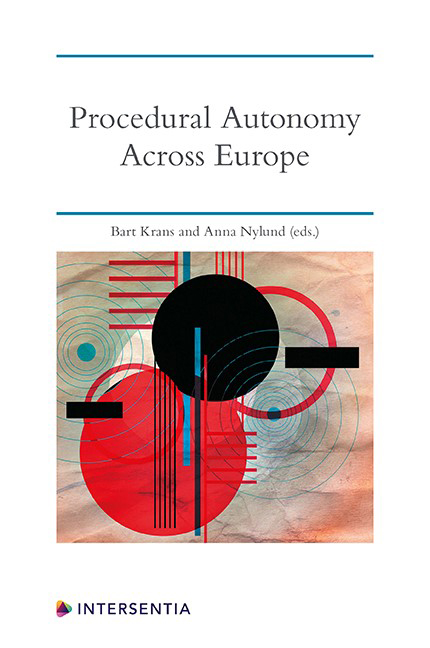Book contents
- Frontmatter
- Preface
- Contents
- Table of Cases
- List of Authors
- Aspects of Procedural Autonomy
- Procedural Autonomy and Belgian Civil Procedure Law: A Turbulent Cohabitation
- The English Approach to Procedural Autonomy
- The Finnish Way of Understanding Procedural Autonomy: A Practical Approach to Implementing EU Civil Procedural Law
- A German Perspective on the Waning Procedural Autonomy in Civil Matters: Who is Afraid of European Civil Procedure?
- Procedural Autonomy in the Netherlands: A Fading Relic?
- Procedural Autonomy, the EEA Agreement and Norwegian Law: The Art of Bridging a Gap and Maintaining it Too
- A Polish Perspective on Collective Civil Proceedings: Reluctance to Follow EU Recommendations?
- Procedural Autonomy between EU Law and the Slovenian Law of Civil Procedure
- Autonomy of the Spanish Legislator in the Regulation of Procedural Law: The Borders of European Case Law
- Procedural Autonomy in Sweden: Is Materielle Prozessleitung the Answer?
- Comparative Insights on Procedural Autonomy
- Index
- ABOUT THE EDITORS
Comparative Insights on Procedural Autonomy
Published online by Cambridge University Press: 30 April 2020
- Frontmatter
- Preface
- Contents
- Table of Cases
- List of Authors
- Aspects of Procedural Autonomy
- Procedural Autonomy and Belgian Civil Procedure Law: A Turbulent Cohabitation
- The English Approach to Procedural Autonomy
- The Finnish Way of Understanding Procedural Autonomy: A Practical Approach to Implementing EU Civil Procedural Law
- A German Perspective on the Waning Procedural Autonomy in Civil Matters: Who is Afraid of European Civil Procedure?
- Procedural Autonomy in the Netherlands: A Fading Relic?
- Procedural Autonomy, the EEA Agreement and Norwegian Law: The Art of Bridging a Gap and Maintaining it Too
- A Polish Perspective on Collective Civil Proceedings: Reluctance to Follow EU Recommendations?
- Procedural Autonomy between EU Law and the Slovenian Law of Civil Procedure
- Autonomy of the Spanish Legislator in the Regulation of Procedural Law: The Borders of European Case Law
- Procedural Autonomy in Sweden: Is Materielle Prozessleitung the Answer?
- Comparative Insights on Procedural Autonomy
- Index
- ABOUT THE EDITORS
Summary
INTRODUCTION
This concluding chapter sets forth to answer the questions posed in the introductory chapter to this book. The book's aim was to explore whether there are any differences in the way procedural autonomy is conceptualised in the Member States, whether procedural autonomy is more limited in some countries than others; whether some doctrines, principles or pieces pose more problems for national civil procedure than others, and whether some type of issues are more easily integrated to national law directly. It is too soon to give definite answers to these questions, but the contributions in this book bring us a step further. There appear to be both similarities and differences among the Member States. In terms of EU law engendering challenges, the authors congregate to some extent around the obligation for courts to apply EU consumer law in their own motion. Additionally, the sectoral nature of EU civil procedure law (i.e. that it applies only to a specific category of cases) is identified as a problematic issue by several authors.
A discussion of features of EU law generating dissonance with national civil procedure constitutes a common core for the ten contributions in this book. Another shared element can be found in weaknesses in approaches to and implementation of EU law at the national level. Thus, this chapter will concentrate on these issues rather than ‘ranking’ countries or individual pieces of EU law. Section 2 will establish whether there are any differences to the conception of procedural autonomy. Then, a potential clash of procedural cultures will be discussed. Thereafter Section 4 will examine how differences between the EU approach and national approaches to civil procedural law are a source of tension and explain how the quality of EU law impacts national law. Section 5 will explore challenges that could be attributed to suboptimal implementation and awareness of EU law. Section 6 discusses the role of multispeed integration and the final section (7) questions whether procedural autonomy is still a useful concept.
THE CONCEPTION OF PROCEDURAL AUTONOMY
The introductory chapter traced the genesis to ECJ case law addressing situations in the absence of EU procedural law, impelling national courts to apply the principles of effectiveness and equivalence, as well as the principle of efficient judicial protection. In the meantime, an extensive and variegated body of EU civil procedure law has emerged.
- Type
- Chapter
- Information
- Procedural Autonomy Across Europe , pp. 227 - 244Publisher: IntersentiaPrint publication year: 2020
- 2
- Cited by

